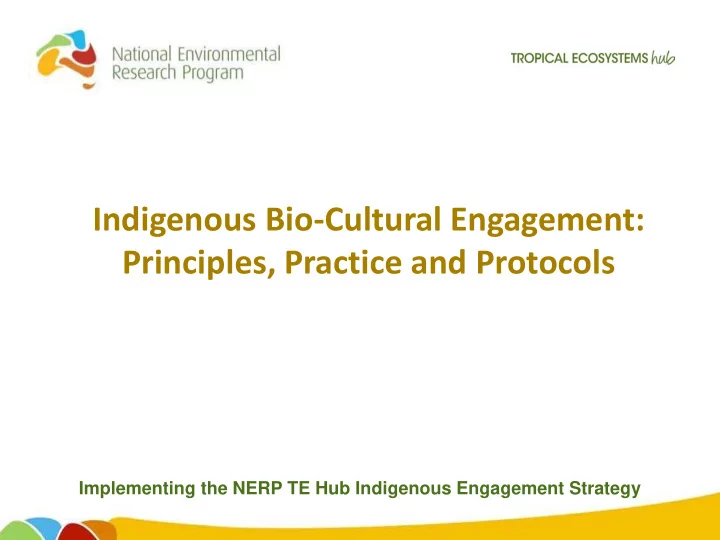

Indigenous Bio-Cultural Engagement: Principles, Practice and Protocols Implementing the NERP TE Hub Indigenous Engagement Strategy
UN Declaration on the Rights of Indigenous People Affirming that all peoples contribute to the diversity and richness of civilizations and cultures, which constitute the common heritage of humankind,…. Recognizing that respect for Indigenous knowledge, cultures and traditional practices contributes to sustainable and equitable development and proper management of the environment,…. Article 31 1. Indigenous peoples have the right to maintain, control, protect and develop their cultural heritage, traditional knowledge and traditional cultural expressions, as well as the manifestations of their sciences, technologies and cultures, including human and genetic resources, seeds, medicines, knowledge of the properties of fauna and flora, oral traditions, literatures, designs, sports and traditional games and visual and performing arts. They also have the right to maintain, control, protect and develop their intellectual property over such cultural heritage, traditional knowledge, and traditional cultural expressions. 2. In conjunction with indigenous peoples, States shall take effective measures to recognize and protect the exercise of these rights.
INSIGHT FROM THE CULTURAL SECTOR The appropriation of Aboriginal artwork and design is not just stealing ideas, but stealing ideas based on cultural knowledge handed down over generations; and the depicted stories have no meaning to the producer. See "Our Culture, Our Future”, Terri Janke, 1998 p 40 “Indigenous intellectual property consists of the intangible ideas and knowledge associated with artistic works and designs and other forms of cultural expression such as music, dance, song and story” Indigenous people stress the strong connections between intellectual and cultural property and other parts of their cultural heritage, particularly to country and their sense of identity. Indigenous rights in cultural and intellectual property include the right to determine its nature and extent in accordance with their laws and customs, the right to manage and control it, and the right to exclude others from access to and use of this property.”
RAP and 20 years’ rainforest research: • 5 years of the Marine and Tropical Sciences Research Facility (MTSRF), 2006 – 2010 Rainforest Aboriginal people were involved with MTSRF mainly through the Aboriginal Rainforest Council (ARC) and Girringun Aboriginal Corporation. Before MTSRF there was 13 years of the Cooperative Research • Centres’ (CRC) program, 1993 – 2006 • Rainforest Aboriginal people were supported through the Rainforest CRC to develop the Aboriginal Plan (2005) and input to the Wet Tropics NRM Plan. • The Rainforest CRC had as one of its 6 goals: “To promote Indigenous involvement in all facets of research and management which will incorporate recognition and respect for Indigenous rights and interests” (RRRC, 2006) • Traditional Owners are clear about adding culture along with environmental, social and economic decision making.
The underpinning protocols for researching Australian Indigenous cultural information GERAIS http://www.aiatsis.gov.au/research/ethical.html A. Rights, respect and recognition B. Negotiation, consultation, agreement and mutual understanding C. Participation, collaboration and partnership D. Benefits, outcomes and giving back E. Managing research: use, storage and access F. Reporting and compliance • Your institutional ethics frameworks • SEWPAC Indigenous Engagement Guidelines
Outcomes >100 culture and country Rainforest Aboriginal peoples’ organisations across the 20 Traditional Owner groups, individuals and groups are looking To utilise research for Traditional Owner work To ensure Traditional Owner interests and concerns are included across mainstream research and developments To the good business sense for including cultural perspectives, for research to follow ethical practice regarding Indigenous interests and involvement.
THANK YOU Me lissa Ge o rg e L e a h T a lb o t Sta n L ui
Recommend
More recommend